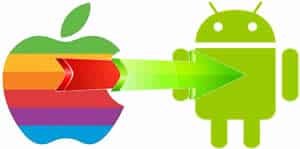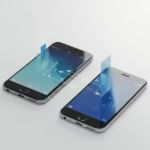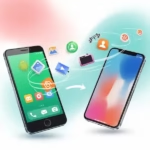Making the Seamless Leap: Your Guide to Transfer Data from iPhone to Android
The tech world is a vibrant landscape of innovation, with both Apple’s iPhone and Google’s Android offering compelling experiences. While many find comfort in their chosen ecosystem, there are times when the allure of a new device, different features, or even just a change of pace prompts a switch. If you’re an iPhone user contemplating a move to Android, the thought of transferring your precious data might seem daunting. Fear not! This comprehensive guide will equip you with the knowledge and tools to make the transition as smooth as possible.
Why Make the Switch? iPhone vs. Android
Before diving into the “how,” let’s briefly touch upon the “why.” Both iPhone and Android have their unique strengths. Understanding these can help affirm your decision to switch:
iPhone Strengths:
- Simplicity and Ease of Use: iOS is renowned for its intuitive interface and streamlined user experience.
- Strong Ecosystem Integration: Seamless integration with other Apple products and services (iCloud, Apple Watch, Mac).
- Privacy and Security: Apple’s strong emphasis on user privacy and robust security features.
- Timely Software Updates: Consistent and long-term software support for older devices.
Android Strengths (and why you might switch):
- Variety and Customization: A vast array of devices from different manufacturers, offering diverse designs, price points, and hardware features. Unparalleled customization options for the user interface.
- Openness and Flexibility: Greater control over file management, app sideloading (installing apps from outside the official app store), and system-level tweaks.
- Affordability: Android devices are available across all price ranges, making them more accessible.
- Google Services Integration: Deep integration with Google’s extensive suite of services (Gmail, Google Drive, Google Photos, Google Assistant).
- Expandable Storage: Many Android phones offer microSD card slots, allowing for affordable storage expansion.
- More Port Options: USB-C is standard, offering wider compatibility.
Ultimately, the choice comes down to personal preference and priorities. If the flexibility, customization, and wider device selection of Android appeal to you, then making the switch can be a rewarding experience.
Preparing for the Transfer: Your Pre-Flight Checklist
Before you begin the transfer process, a little preparation goes a long way:
- Charge Both Devices: Ensure both your iPhone and your new Android device are fully charged to avoid interruptions during the transfer.
- Stable Wi-Fi Connection: For wireless transfers, a strong and stable Wi-Fi connection is crucial.
- Google Account: Have your Google Account credentials ready. If you don’t have one, create one – it’s essential for your Android experience.
- Back Up Your iPhone: While you’re transferring data, it’s always wise to have a complete backup of your iPhone.
- iCloud Backup: Go to
Settings>[Your Name]>iCloud>iCloud Backupand tapBack Up Now. - iTunes/Finder Backup: Connect your iPhone to your computer and back up via iTunes (Windows) or Finder (macOS).
- iCloud Backup: Go to
- Disable iMessage: This is a critical step to ensure you continue receiving text messages on your new Android phone.
- Go to
Settings>Messagesand toggleiMessageoff. - It’s also a good idea to deregister your number from iMessage on Apple’s website if you encounter issues later.
- Go to
- Update Software: Ensure both devices are running the latest compatible software versions for optimal transfer performance.
Transferring Your Data: Wireless vs. Cable
There are two primary methods for transferring data from your iPhone to an Android device: wirelessly or via a cable. Each has its advantages.
1. Wireless Transfer Data from iPhone to Android
Wireless methods are generally more convenient, requiring no special cables or adapters.
A. Google’s “Switch to Android” App (Recommended for most Androids)
Google’s official “Switch to Android” app is designed to simplify the migration process for most Android devices.
- What it transfers: Contacts, messages, photos, videos, calendar events, and some free apps available on both platforms. WhatsApp chat history can also be transferred.
- How it works:
- On your new Android device: During initial setup, when you reach the “Copy apps & data” screen, select the option to transfer from an iPhone or iPad. You might see a QR code.
- On your iPhone: Download and open the “Switch to Android” app from the App Store.
- Connect: If prompted, scan the QR code displayed on your Android phone with your iPhone’s camera (or follow on-screen instructions to connect wirelessly via a temporary Wi-Fi network created by your Android).
- Select Data: Choose the data you want to transfer.
- Transfer: The transfer will begin. Keep both devices close and charged until complete.
B. Manufacturer-Specific Apps (e.g., Samsung Smart Switch, OnePlus Switch)
Many Android manufacturers provide their own migration tools, which often offer a more comprehensive transfer experience tailored to their devices.
- Samsung Smart Switch:
- What it transfers: Contacts, messages, call logs, photos, videos, music, calendar, documents, and even Wi-Fi settings, home screen layouts, and some third-party app data.
- How it works:
- On your new Samsung Galaxy: During setup, you’ll be prompted to use Smart Switch. If you’ve already set up your phone, download Smart Switch from the Google Play Store.
- On your iPhone: Download Smart Switch from the App Store.
- Connect: You can choose to connect wirelessly (both devices on the same Wi-Fi) or via cable (see cable method below). Follow the on-screen prompts to select data and initiate the transfer.
- Other Manufacturers: Check your new Android phone’s documentation or visit the manufacturer’s website for their specific transfer app (e.g., OnePlus Switch, LG Mobile Switch).
C. Cloud Services (for specific data types)
For certain data, cloud services offer a convenient way to sync information across platforms.
- Google Photos: Back up all your photos and videos from your iPhone to Google Photos. Once you sign into your Google Account on your Android, they’ll automatically sync.
- Google Drive/Dropbox: Upload documents, files, and other media to cloud storage. You can then access and download them from your Android.
- Gmail/Google Calendar/Google Contacts: Ensure your contacts and calendar are synced to your Google Account on your iPhone. They will automatically appear on your Android once you log in.
2. Transfer via Cable to Transfer Data from iPhone to Android
The cable method often provides faster and more reliable transfers, especially for large amounts of data.
- What you’ll need: A Lightning to USB-C cable (if your new Android has a USB-C port) or a Lightning to USB-A cable and a USB-A to USB-C/Micro USB adapter. Many new Android phones come with an adapter for this purpose.
- How it works (generally with Google’s or manufacturer’s app):
- Connect devices: Plug the Lightning end into your iPhone and the USB-C/adapter end into your new Android phone.
- Trust Device: On your iPhone, you may need to tap “Trust This Computer” or “Allow” when prompted.
- Initiate Transfer: On your Android phone, during initial setup, select the option to copy data from your old device and choose the cable method.
- Select Data: Follow the on-screen prompts to select the data you wish to transfer.
- Transfer: The data transfer will begin. Keep the cable connected until the process is complete.
Transfer Data from iPhone to Android Capabilities – Comparison Chart
| Feature/Method | Google’s “Switch to Android” App | Samsung Smart Switch (to Samsung) | Cloud Services (Google Photos/Drive) | Cable Transfer (general) |
| Contacts | Yes | Yes | Yes (Google Contacts) | Yes |
| Messages (SMS) | Yes | Yes | Limited/No | Yes |
| iMessage History | Yes (requires WhatsApp transfer) | Yes | No | Yes |
| Call History | Yes | Yes | No | Yes |
| Photos & Videos | Yes | Yes | Yes (Google Photos) | Yes |
| Music | Limited (non-DRM) | Limited (non-DRM) | Via cloud/manual transfer | Limited (non-DRM) |
| Calendar Events | Yes | Yes | Yes (Google Calendar) | Yes |
| Notes | Yes | Yes | Yes (Google Keep/Docs) | Yes |
| WhatsApp Chats | Yes | Yes (specific versions) | Yes (specific versions) | Yes |
| Apps (matching) | Yes (free apps) | Yes (free apps) | No (re-download from Play Store) | No (re-download) |
| App Data | Limited | Some | No (depends on app) | Limited |
| Wi-Fi Settings | No | Yes | No | No |
| Home Screen Layout | No | Yes | No | No |
| Speed | Moderate (Wi-Fi) | Fast (cable), Moderate (Wi-Fi) | Varies (internet speed) | Fast |
| Ease of Use | Very Easy | Easy | Moderate | Easy |
| Requires Computer? | No | No | No | No (can be direct phone-to-phone) |
Note on DRM-protected content (Music, Movies): Content purchased from iTunes with Digital Rights Management (DRM) protection may not transfer directly. You might need to remove DRM or use streaming services compatible with Android.
Beyond the Basics: Additional Helpful Content
- App Migration: While some apps transfer, you’ll generally need to re-download your apps from the Google Play Store. Most major apps are available on both platforms, and your login credentials will carry over. For apps with specific data (e.g., games), check if they offer cloud saves or specific migration tools within the app itself.
- Password Management: If you use iCloud Keychain, consider switching to a cross-platform password manager like LastPass, 1Password, or Google Password Manager before you switch. This will make accessing your saved logins on your Android device seamless.
- iMessage Deregistration: Reiterate the importance of turning off iMessage on your iPhone. If you don’t, messages from other iPhone users might continue to be sent to your old iPhone number as iMessages, and you won’t receive them on your new Android.
- Explore Android Features: Once your data is transferred, take time to explore the unique features of your new Android device and the Android operating system. Customize your home screen with widgets, try different launchers, and delve into settings to truly personalize your experience.
Troubleshooting Common Problems to Transfer Data from iPhone to Android
Even with the best preparation, you might encounter a few hiccups. Here are some common issues and their solutions:
- Transfer Stuck/Slow:
- Check Wi-Fi: Ensure both devices are connected to a strong, stable Wi-Fi network.
- Restart Devices: Sometimes a simple reboot of both phones can resolve connectivity issues.
- Reduce Data: If you have a massive amount of data, try transferring in smaller batches or deselecting less critical data types.
- Try Cable: If wireless is failing, switch to a cable connection if possible.
- “Can’t scan QR code” or Connection Issues:
- iPhone Camera Permissions: Make sure the “Switch to Android” app has camera permissions on your iPhone.
- Restart App: Close and reopen the transfer app on both devices.
- Disable VPN: If you have a VPN enabled on either device, temporarily disable it.
- Check Auto-Join Wi-Fi: On your iPhone, ensure “Auto-Join” is off for any other Wi-Fi networks during the temporary Wi-Fi connection phase.
- Missing Text Messages on Android:
- Deregister iMessage: This is almost always the cause. Ensure iMessage is turned off on your iPhone and visit Apple’s iMessage deregistration page.
- Group Chats: You might need to start new group chats with iPhone users if the old ones were iMessage-based.
- Not Enough Storage on New Android:
- Free Up Space: Delete unnecessary files or apps on your iPhone before transfer.
- Select Fewer Items: During the transfer process, choose to transfer only essential data (e.g., contacts, photos) initially, and then manually transfer other data later.
- Cloud Sync: Utilize cloud services like Google Photos for media to avoid local storage issues.
- Apps Not Transferring/Data Missing in Apps:
- App Availability: Confirm the app is available on the Google Play Store.
- Login & Sync: Log in to the apps on your Android phone. Many apps sync data automatically once you’re signed in.
- Developer Support: For specific app data, check the app developer’s website for migration instructions or cloud sync options.
Frequently Asked Questions (FAQ) to Transfer Data from iPhone to Android
Q1: How long does the data transfer take? A1: The transfer time varies greatly depending on the amount of data and the transfer method (wireless vs. cable). A few gigabytes can take minutes, while hundreds of gigabytes could take an hour or more.
Q2: Will all my apps transfer to my new Android? A2: No, not all apps will transfer. Only free apps that have a direct match on the Google Play Store will typically be automatically downloaded. You will need to re-download most apps and log in. Paid apps will need to be repurchased if they are not cross-platform compatible.
Q3: Can I transfer my WhatsApp chat history? A3: Yes, both Google’s “Switch to Android” app and Samsung Smart Switch (and some other manufacturer apps) now support WhatsApp chat history transfer from iPhone to Android. Ensure both devices are updated and follow the specific instructions within the transfer app.
Q4: Do I need a computer to transfer data? A4: Not necessarily. Most modern transfer methods, especially Google’s “Switch to Android” and manufacturer-specific apps, allow for direct phone-to-phone transfer, either wirelessly or with a cable.
Q5: What about my photos and videos in iCloud? A5: You can download your iCloud photos and videos to your iPhone, and then transfer them using a direct transfer method. Alternatively, you can use Google Photos on your iPhone to back up your entire photo library to the cloud, and then access them seamlessly on your new Android by signing into your Google Account.
Q6: What if my iPhone and Android don’t have the same port type for cable transfer? A6: You will likely need an adapter. Many new Android phones come with an “OTG” (On-The-Go) adapter that converts a USB-C port to a USB-A port, allowing you to connect a standard Lightning to USB-A cable.
Q7: Is it safe to transfer my data this way? A7: Yes, using official apps from Google or your Android device manufacturer, or reputable third-party tools, is generally safe. These methods are designed to securely transfer your data. Always ensure you’re downloading apps from official app stores.
Additional helpful information
External Links for Authoritative Sources
- Google’s Official “Switch to Android” Guide: https://www.android.com/switch/ (Look for sections on transferring from iPhone)
- Samsung Smart Switch Support: https://www.samsung.com/us/support/smart-switch/
- Apple Support (Deregister iMessage): https://selfsolve.apple.com/deregister-imessage/
Internal Links
If you don’t want to transfer data from iPhone to Android, or vice-versa, you may want to just share the files. Here’s how to share files: How to share files between Android and iPhone devices?
Perhaps you want to switch from Android to iPhone – Transfer Data from Android to iPhone: A Step-by-Step Guide
You may want to share photos and videos between Android and iPhone. Best way to share photos and videos between iPhone and Android
The fastest method to share files from Android to a Windows PC is using Nearby Share. How to copy files from Android to Windows PC wirelessly?
How to transfer data between all devices, Android and iPhone – Seamless Phone File Transfer: iPhone, Android, Cross-Platform
Switching phones, especially between different operating systems, can feel like a big step. However, with the right tools and a little preparation, transfer data from iPhone to Android is now easier than ever. Enjoy your new Android experience!



